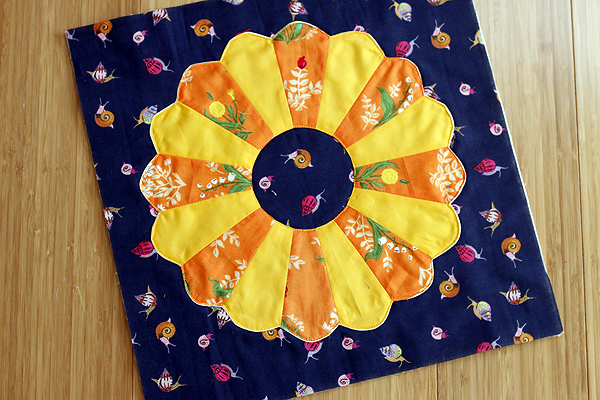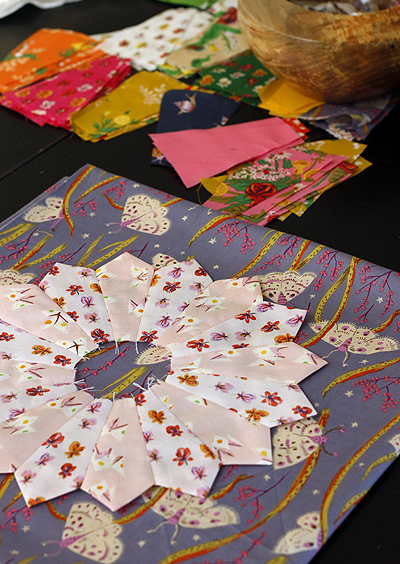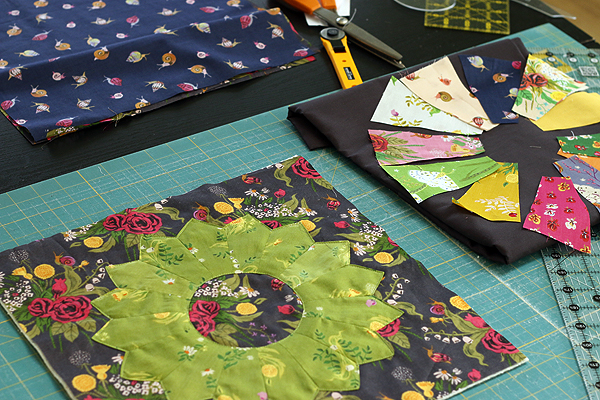Sleeping Porch Dresdens
Do you like dresdens? For so many years, I thought I didn't.
Dresden plates are a traditional block made with many wedges arranged in a circle. Typically you sew wedges to make pointed, turned-under edges. Then you join those wedges to form a circle, applique the dresden on a background and cover the center of the dresden plate with a smaller applique circle.

vintage quilts on aqua and on white
When you begin quilting you start looking at quilts in a new way, often thinking, "Do I want to make that?" Usually the answer was "no" for me with dresden plate quilts. But from time to time I'd see one that was different. Exactly how, I wasn't sure... In 2015 I first attempted to capture the kind of dresdens I favor via an Inspiration post. Finally, two years later I'm making my first dresden quilt. And, I'm finding my way to love them!

It doesn't hurt that I'm starting with a gorgeous fabric collection: Sleeping Porch by Heather Ross. The dreamy, lightweight lawn fabrics should yield an applique quilt that is still supple despite multiple layers.
If you're sewing with Sleeping Porch, try a Microtex Sharp size 10 needle, which easily pierces the tighter weave, and avoid steam since they seem to distort easier than quilting cottons. Also, I suggest you don't mix heavier weight quilting cottons in your lawn patchwork. Best to keep all fabrics the same weight (lawn, voile, muslin, etc.) so that the seams will not fray. I know by experience that mixed-weight quilts, while lovely, don't hold up well to family use.

So, back to the dresdens! First I found that I prefer dresdens with sixteen wedges rather than the more popular twenty. The wedges are bigger this way. Also I like a large circular center and even better if the center is the same fabric as the background. This creates a dresden circle that seems to float on the background fabric. I made three different dresdens over the last week to test my custom-designed template. The green dresden was my first. It has pointed edges and a slightly too-large center circle. The pale peach dresden is my second. It has curved edges, but not quite enough curve. It's vaguely donut-like, right?

Here is my third dresden. Now the curve proportions and circle size are just right, and there is an ideal amount of contrast between my two dresden prints. Yay! Do you like?
Don't worry, I plan to use all of my dresdens. I'm planning to have variety in the quilt with both curved and pointed-edge plates. The more the merrier!

At first I thought I'd consistently use the charcoal gray print or solid gray for my backgrounds, but now I am planning to use a variety of the darker Sleeping Porch prints. This gray-purple moth print is dreamy with the pinks. Also, I need more of the navy snails!

For the center circles I'm actually using a reverse applique technique that's quick and saves fabric. After going to all the trouble to develop the perfect (for me) dresden templates and figure out the reverse applique technique, I am considering creating a pattern. Let me know if there is interest, OK?
Hmm... what do you think about a few multi-color, wild dresdens with lots of prints on the solid gray? I can't quite decide if I want to go that way or keep things more dreamy and soft.